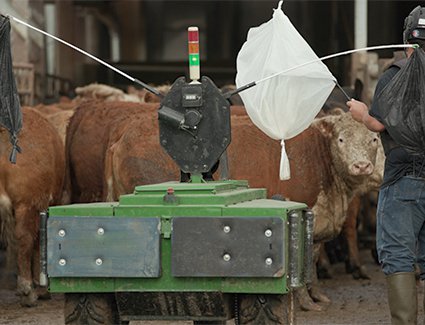
A major beef plant in the US has introduced a remote-controlled, two-armed, bag-waving robot called 'R2DMoo' to make their operations safer.
The size of the average cattle moving through Cargill’s beef plant in Schuyler, Nebraska is three quarters of a ton, and the farm sees around 5,000 cattle move through on a daily basis.
The agricultural giant said it understood the scale of the potential safety risks that are inherent to working alongside such animals.
“These are very large animals that we deal with,” said Sammy Renteria, general manager at the plant. “And it’s something that causes concern because there is no way of knowing what the animal is going to do.”
As the herd clears from each pen, the gates close and the workers, who wear helmets and chest pads, move outside a series of rails; waving plastic bags tied to sticks and calling out commands to help push the cattle forward until the next gate can be closed.
“You’re herding live animals,” said Matt Croghan, supervisor. “They could turn on you, run you over, kick you, hurt you. So, anything we can do to be safer while we do this, we’re going to do.”
But lately, they've had some help from a remote-controller robot named R2DMoo.
Cattle-driving droid
Using a robot to herd cattle was the brainchild of Brad Churchill, plant operations manager.
“One of our vendors sent me a link to a video. And probably within 10 seconds of watching the video, I just immediately knew we could move cattle with that kind of robot.”
The robot was designed to function as a security device. Churchill knew they’d have to make some modifications to successfully transform it into a cattle-driving droid: “We really had to beef it up.”
The body was upgraded from plastic to metal. The wheels were redesigned to move agilely along the trampled and sometimes muddy ground.
A blower was added the ability to press the cows forward without actually touching the animals. Wiry waving arms with plastic bags tied to the ends were added to whip back and forth, mimicking the sound and motion of the workers waving theirs.
And there was one other essential addition to the machine as iterative changes were made: a voice to help prompt the animals by saying, “Hey! Hey! Hey! Come on. Let’s move it!”
Churchill’s team made these tweaks to the technology as they began testing the robot at multiple Cargill beef plants, starting at the Wyalusing, Pennsylvania, facility.
The robot is operated via remote control by a worker standing on catwalks that overlook the pens. While people still need to be inside the pens, closing the gates off as the cattle travel toward the plant, the robot allows them to keep a greater distance from the animals.
